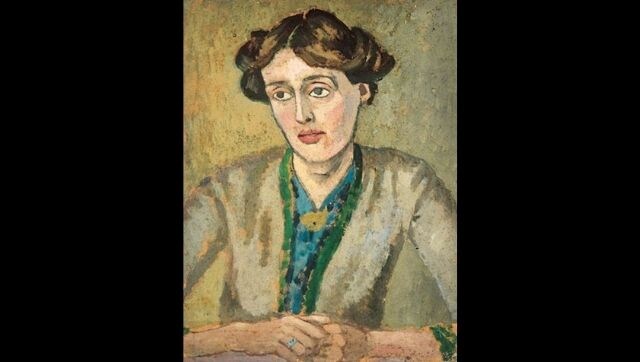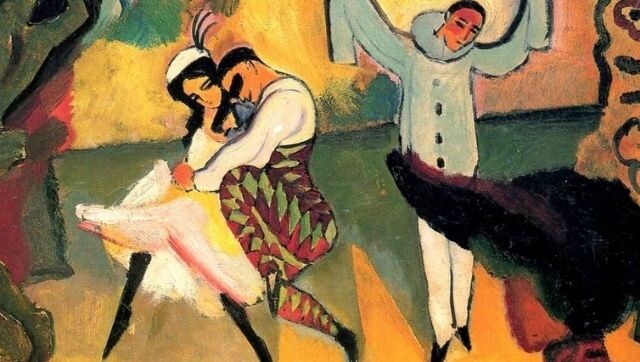Mrs Dalloway is a text that shows how memory and mourning work to uphold the values of the British Empire. Its attention on how emotions circulate between people allows us to understand how national structures of feeling are created through newspapers and through the orchestration of symbolic identifications.

Virginia Woolf painted by Roger Eliot Fry.
Image via The Conversation/ Leeds Museums and Galleries, CC BY-NC
By Jess Cotton
The Conversation March 29, 2021
By Jess Cotton
The Conversation March 29, 2021
Illness, unlike war, as English academic and writer Elizabeth Outka brilliantly demonstrates in her book Viral Modernism (2019), is a story that easily slips out of cultural and historical memory.
In illness, the modernist writer Virginia Woolf observed, “We cease to be soldiers in the army of the upright; we become deserters.” Woolf, writing in the wake of the first world war, saw the threat that the Spanish flu of 1919 posed to the stories of national triumph. Influenza moves in invisible and unpredictable ways. It renders everyone potentially vulnerable.
This interest in illness was personal. Woolf came down with several bouts of influenza between 1916 and 1925 and needed to confine herself to bed for stretches of time.
She documents the experience of the Spanish flu in her diary in 1918, noting, as an aside, how “we are, by the way, in the midst of a plague unmatched since The Black Death, according to the Times, who seem to tremble lest it may seize upon Lord Northcliffe and thus precipitate us into peace.”
Her tone is mocking. She would later appreciate the seriousness the threat of influenza posed. But here she suggests that what illness promises to bring is the end of the profit of war that fuels the nationalist sentiments churned out by the newspapers owned by Lord Northcliffe’s vast empire of popular journalism.
Reading Woolf’s work, particularly her 1925 novel Mrs Dalloway, on the 80th anniversary of her death and in the midst of our own pandemic, we see how she tried to rewrite death and illness back into the national story of post-first world war glory and strength.
Sidelining death
I’m a lecturer in English at Cardiff University, and teaching literature in a sparsely filled lecture theatre during the pandemic has been a discombobulating experience. Mrs Dalloway provided an entry point to make sense of the business of studying and thinking while a new national emergency unfolded around us. The protagonist of Mrs Dalloway is a survivor of the Spanish flu of 1919 and the sense of life that permeates the text emerges from her experience of rediscovering the pleasures of life. We meet Mrs Dalloway as she weaves her way through London, experiencing the quiet intensity of life one morning in June.
The novel’s famous opening line –'Mrs Dalloway said she would buy the flowers herself' – has taken on new resonance this year as the pandemic has made all our worlds much smaller. Clarissa wants to buy the flowers herself because she is delighted to go out – as we might appreciate – having spent so long indoors.
In class, the students and I thought about what it meant to see Clarissa as a character who has lived through a pandemic and who has come out the other side. Clarissa’s commitment to life, after a long confinement, is hopeful, though my students weren’t all convinced that it felt like one.
At the centre of Clarissa’s party, which the novel builds to, comes the news that Septimus Smith, a young war veteran, has killed himself. In Woolf’s original plans for her novel, Septimus did not appear and Clarissa was to kill herself during the party. In creating Septimus as Clarissa’s double, Woolf is able to move death to the sidelines – as we all would like to.

The Spanish influenza of 1918 was a plague that posed a serious threat and moved in the most unpredictable ways. Image via The Conversation/ Science History Images Alamy
Woolf revolutionises character by radically tunnelling inwards – giving us not a description of a character, but a map of their psychic life. We experience the protagonist intimately from within – through their stream of consciousness – but peripheral characters also proliferate in the modernist novel.
Woolf recognises how easily it is to cast characters to the sidelines of life. This is, after all, how national fictions work, by making space for protagonists at the expense of those who are pushed further out of view. In the case of post-war Britain, space was made for the glory of war but not for the the Spanish flu.
Collective memory
Mrs Dalloway is a text that shows how memory and mourning work to uphold the values of the British Empire. Its attention on how emotions circulate between people allows us to understand how national structures of feeling are created through newspapers and through the orchestration of symbolic identifications.
“In all the hat shops and tailors’ shops strangers looked at each other,” Woolf writes, “and thought of the dead; of the flag of Empire.” Woolf is interested in showing something that is hard to pinpoint: how national communities are created and sustained; how the war’s dead continue to underpin an inexorable sense of Britishness.
Woolf saw that a subjective perspective was required to make sense of how death continues to inflect the mood of a generation. Mourning, as Sigmund Freud also realised at a similar point, is ongoing, illusory work. What is remarkable about her writing is that Woolf draws our attention to how death pushes us beyond what we can know. In this unknowing, we are forced to admit that our lives are more fragile and dependent on the lives of others.
As one of her characters articulates in The Voyage Out (1915):
“It seems so inexplicable,” Evelyn continued. “Death, I mean. Why should she be dead, and not you or I? It was only a fortnight ago that she was here with the rest of us?”
Woolf’s ability to show how hard it is to explain death helps us understand the difficulty of living with its presence. In the face of the loneliness of death, the growing demise of its communal forms, the diminished structures of public mourning, she provides us with a language for death outside of national structures of commemoration.

Jess Cotton is Lecturer at the School of English, Communication and Philosophy, Cardiff University
This article is republished from The Conversation under a Creative Commons license. Read the original article.
Updated Date: March 29, 2021
How music and contemporary composers influenced Virginia Woolf's literature, creative innovations
Music provided Woolf (and other modernists including James Joyce, Ezra Pound, Gertrude Stein and Katherine Mansfield) with a vocabulary to imagine and describe their creative practice and formal innovations.

Virginia Woolf listened to a widesian ballet music which she heard when the Ballets Russes visited London in 1912. Image via variety of music, including Rus The Conversation/ Wikimedia Commons
By Emma Sutton
The Conversation March 28, 2021
Many of Virginia Woolf’s early reviewers noted parallels between her literary innovations and those of contemporary composers, such as Claude Debussy. Woolf’s interest in music was overlooked after her death. However, 80 years on, we are now beginning to explore how her extraordinary experimental uses of narrative perspective, repetition and variation derive from her close study of particular musical works and specific musical forms.
Music provided Woolf (and other modernists including James Joyce, Ezra Pound, Gertrude Stein and Katherine Mansfield) with a vocabulary to imagine and describe their creative practice and formal innovations. Woolf, for instance, compares her diary writing to a pianist practising their scales. She describes her reading as a process of “tuning up” for her writing. And in 1940 she famously observed:
It’s odd, for I’m not regularly musical but I always think of my books as music before I write them.
Music in Woolf’s life
Woolf grew up immersed in music. As a young woman, she attended operas and concerts at the Royal Opera House three or four times a week – sometimes, every night. Like most women of her age and social class, she had received basic music education in singing and piano. But her passion as a listener far outstripped her abilities as a performer.
Her letters and diaries repeatedly convey her love of classical repertoire – particularly the works of Bach, Mozart, Beethoven and Wagner. But she heard a wide variety of music in varied settings. She heard folk music as she travelled in England, Scotland and continental Europe. Took in comic and patriotic songs in music halls. Delighted in the work of Arnold Schoenberg and another avant-garde repertoire through her subscription membership of the National Gramophonic Society, and Russian ballet music when the Ballets Russes visited London in 1912.
Woolf’s Hogarth Press also published studies of contemporary music, composers and popular books of music appreciation. Her understanding of – and in some cases intimate friendships with – leading composers, music critics, conductors and other musicians of her time gave her an insight into professional musical life, too. Friends included the composers and critics Eddy Sackville-West and Gerald Berners, the conductor and educator Nadia Boulanger, and the composer and feminist Ethel Smyth.
Music in Woolf’s writing
Woolf’s feminism, pacificism and cosmopolitanism were significantly shaped by her enduring, passionate love of music. The social conventions surrounding music education, performance and composition catalyse some of her wittiest and most acerbic social comedy but also inform her critiques of, for example, women’s unequal access to music education.
In her first novel, The Voyage Out (1915), Woolf references specific musical works to challenge the established expectation that men and women should play different repertoire. The novel’s female protagonist, who is an accomplished amateur pianist, plays Beethoven’s late piano sonatas. These works were frequently characterised as too technically and intellectually demanding for women performers. Essays addressed to amateur female pianists characterised the works as “simply unattainable.”
Music also influences Woolf’s creative innovations. The double narrative structure of Mrs Dalloway, for example, which contrasts and entwines the lives of society hostess Clarissa Dalloway and traumatised veteran Septimus Warren Smith, may well be modelled on the double form of musical fugues ('fugue' was a contemporary term for shell shock).
Woolf observed in 1909 that, “We are miserably aware how little words can do to render music.” But this difficulty frequently catalyses and becomes a subject of her writing.
It’s perhaps unsurprising, then, that her prose has been a rich source of creative inspiration for composers. For instance, her work inspired Dominick Argento’s 1974 song cycle From the Diary of Virginia Woolf and more oblique responses, such as Max Richter’s music for the 2015 ballet Woolf Works.
In the last 15 years, musical responses to Woolf’s writing have proliferated, from the string quartet and songs premiered by the Virginia Woolf and Music project, to the recent announcement that composer Thea Musgrave is writing an opera inspired by Orlando.
In a 1905 essay, Woolf invited contemporary writers to remember words’ allegiance to music and take inspiration from that. Scholars of Woolf’s work and composers are now, it seems, doing just that.

Emma Sutton, Professor of English, University of St Andrews
This article is republished from The Conversation under a Creative Commons license. Read the original article.
No comments:
Post a Comment